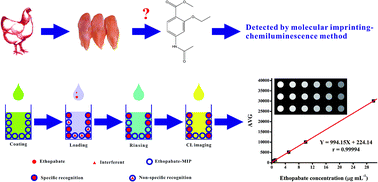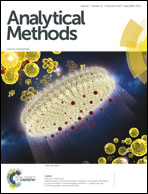Molecularly imprinted polymer-based chemiluminescence imaging assay for the determination of ethopabate residues in chicken muscle
Abstract
A new molecularly imprinted polymer (MIP)-chemiluminescence (CL) method has been developed for the detection of ethopabate (ETP) residues in chicken muscle. The MIP microspheres were prepared using precipitation polymerization with ETP as a template, methacrylic acid as a functional monomer and pentaerythritol triacrylate as a cross-linker in the porogen of acetonitrile. The prepared MIP microspheres were characterized by using a scanning electron microscope, differential scanning calorimeter and Fourier transform infrared spectrometer. The binding properties of ETP on the imprinted polymers were evaluated by the equilibrium rebinding experiment. It was revealed that two classes of binding sites were produced in the resulting ETP MIPs with the dissociation constants of 23.92 μg L−1 and 77.82 μg L−1, and the affinity binding sites of 8808.28 μg g−1 and 14 043.90 μg g−1, respectively. As the artificial biomimetic recognition element for ETP, the polymer microspheres were immobilized in microtiter plates (96 wells) with poly(vinyl alcohol) as a glue. Through the optimization of the MIP absorption and CL imaging conditions, ETP was quantified based on the peroxyoxalate CL reaction enhanced by imidazole. Under the optimum conditions, the relative CL intensity has a linear relationship with the ETP concentration in the range of 0.1 μg mL−1 to 30 μg mL−1, with a limit of detection of 14.7 μg kg−1 and a limit of qualification of 20.4 μg kg−1 in chicken muscle. The recoveries of spiked ETP are in the range of 99.80% to 99.98% with a relative standard deviation of 1.7% to 3.4%. For the first time, the CL method combined with MIPs was developed to determine trace ETP in real samples, and the results show that it can become a useful analytical tool for quick detection in residue analysis.

- This article is part of the themed collection: Detecting food authenticity and integrity

 Please wait while we load your content...
Please wait while we load your content...